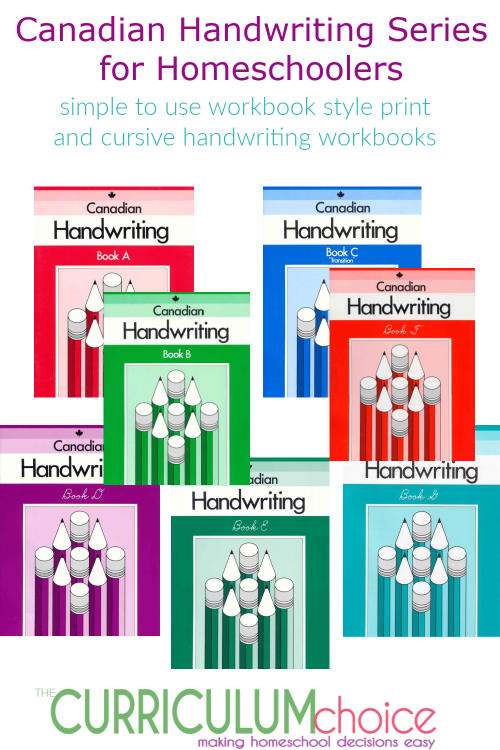For years we did not use a handwriting program. Miss 18 learned cursive from Richard Scarry’s big picture books and the handwritten examples I made up for her in a little scribbler. She was enthusiastic and learned quickly.
My son, on the other hand, was not enthusiastic. He even had trouble printing. When I tried to teach him cursive using my own examples, I soon concluded he was not ready. The trouble was, he never, ever did become ready, and now he’s 16 and still finds cursive difficult.
Even though Miss 13 learned well and quickly, Miss 10 is as reluctant as her brother.
So I’ve made a decision. Ready or not, the Little Misses are learning cursive. If it’s hard, they can go slowly, but they will practice. Regularly.
Canadian Handwriting Series for Homeschoolers

There are many beautiful and involved handwriting programs out there, but we chose a simple, convenient, no-frill set of workbooks with a solid track record, the Canadian Handwriting Series.
Books A to G are available, with the transition from printing to cursive in Book C. Each book has 80 pages full of careful examples and lots of practice space.
Canadian Handwriting Series Book Levels
- Book A – introduces manuscript handwriting and is intended for Grade 1.
- Book B – continues with manuscript handwriting and is intended for Grade 2.
- Book C – is the transition from manuscript to cursive handwriting and is intended for Grade 3.
- Book D – continues with cursive and is intended for Grade 4.
- Book E – continues with cursive and is intended for Grade 5.
- Book F – continues instruction and practice with cursive and is intended for Grade 6.
- Book G – continues instruction and practice with cursive and is intended for Grade 7.
Each letter is taught on its own page, and similar letters are taught consecutively. Numbered letter strokes show the child exactly how to make each letter. The first three books have dashed-line examples for the children to trace before they try to make the letters on their own.

In later books, more detailed instruction, including written description of the letters, is given. Common mistakes are pointed out, and troublesome letters and letter combinations are carefully reviewed. Students are even taught how to evaluate their writing and improve it:

Sometimes the practice sentences discuss Canada, so this handwriting series teaches the students some geography and interesting facts as well. However, the Canadian content is not overwhelming, at least in levels C and D which we have used. Here’s the page on Canada at the end of level D:

All I, as a mom, have to do is encourage, help with a few tough letters when the transition to cursive is made, and correct the pages. That’s a whole lot easier than making personalized lessons for each child!
My Only Complaint
The only complaint I have is that these books teach children to make loops in the bottom of the ‘p,’ which leads to messy-looking writing. I’ve told my children to avoid the loops, and that works most of the time.

I’m pleased with the Canadian Handwriting Series and wish we had used them for all our children.
More Homeschool Handwriting Options

Homeschool Handwriting Resources – Includes both print and cursive options
Homeschool Cursive Handwriting Resources for Elementary – “Are you wanting to teach cursive writing to your kids? In my opinion, handwriting is still so important even in this digital age. We included cursive writing in our homeschool because writing things down helps so much in helping remember and recall information. We wanted our daughter to know print and cursive, so she would have two options to choose from. Here are cursive handwriting resources for elementary.”
~ Written by Annie Kate, a Christian homeschooling mom of five. You can read her other Curriculum Choice reviews here.

I had never heard of it! So glad you shared it with us. I like how this series teaches children how to critique their own handwriting. Thanks.
Here’s a funny story for you – my niece a few years ago in 3rd grade started cursive and was graded and got a B. When she grew up into middle school and dropped cursive, she had typewriting handwriting and it looked perfect. Just something to think about. Good luck with cursive!
Thank you for this thorough description and pictures! I looked everywhere for some sample pages without any luck, so I really appreciate your review.
This is like the handwriting I learnt as a kid in Vancouver in the 1940s. But when I came back to the UK in the 1950s, my use of the lower case “r” was questioned. So I changed to what I assumed was a more modern “r”, looking similar to the typeset in this comment. But going back to 19th century documents, I find that both shapes were in use then. One American writer referred to the modern one as “standard”, and the other as “modified”. I also found the old “r” referred to as D’Nealian script, and German Roundhand. I’m not really much wiser. Help! Does anyone know which came first? And are any Canadians taught what I call the “modern r”.
There are many different ways of writing, and I really wouldn’t know. Sorry.
For examples of many different types of handwriting, check out the fonts in the samples of Presidential Penmanship. You can find links to that program here: https://www.thecurriculumchoice.org/2012/06/presidential-penmanship-2/ I hope that helps.
Thanks Annie, I found the examples by looking for the book Presidential Penmanship, although the exact link reference was “page not found”. The “r” as shown I have also seen described elswhere as “child cursive”. Whereas the typeface shaped “r” was described as “adult cursive”. This could be the answer to my question. Maybe the child cursive “r” was derived so that both lead in and lead out strokes came back to the bottom line of the text. Just my theory: it results in a consistent rule in teaching children cursive writing, as used in Canadian writing.
Best wishes, Brian
Do Canadian mainstream schoolchildren follow a consistent handwriting style? I teach in Australia where each state has it’s own handwriting ‘font’ (in Queensland we use ‘Queensland Beginners’ for our foundation year level) and I’m wondering if other countries have a similar system? Thanks!